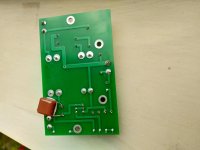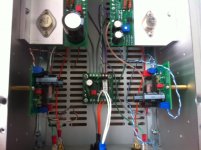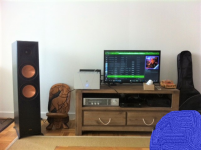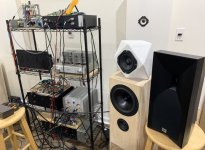Thank You
Ordered them 😀 there two shipping is discounted right now!!!
Ahh, too bad about blowing the big cap. The Rubycon caps that came with the kit are decent ones. If you are looking for an alternate, these would be a good way to go:
https://www.mouser.com/ProductDetail/Nichicon/LKG1H103MESCBK?qs=4lWw5qRttGJcrVu0WisRew==
Ordered them 😀 there two shipping is discounted right now!!!
Gutted Sony TA 4650 chassis looks promising. Attaching a small smps 18V power source to the internal preamp works great and preamp sounds excellent through headphones. Built in preamp is two fet cascodes in series it appears, but the circuit boards are all mixed up with the parts in arcane vintage Japanese style.
Plenty of room for the 36v SMPS and various cards.
I have been going cross eyed deciphering 4650 circuit diagrams to find takeoffs for inputs.
If I can do the first build successfully, I have a second 4650 chassis that i will incorporate with the Korg card into as preamp with VFET output. Waiting for outside chance on next lottery, or NP's future card schemes for my different VFETs.
Plenty of room for the 36v SMPS and various cards.
I have been going cross eyed deciphering 4650 circuit diagrams to find takeoffs for inputs.
If I can do the first build successfully, I have a second 4650 chassis that i will incorporate with the Korg card into as preamp with VFET output. Waiting for outside chance on next lottery, or NP's future card schemes for my different VFETs.
Ok now #37 is a live.
Ok my upgrade parts showed up yesterday. Well they are a very tight fit, or not. Can anyone think of a reason that bumping up against C5 is bad thing or is just slop.
Ok WOW I love the sound of this amp. I think I just became a “Class A” guy now and forever. The low volume bass is outstanding.
My nabor was yelling at me for adj the bias with no speaker hooked up. He said there many reasons for never powering up a amp with out speaker hooked up. Nelson do you have any insight for me on this.
Ok my upgrade parts showed up yesterday. Well they are a very tight fit, or not. Can anyone think of a reason that bumping up against C5 is bad thing or is just slop.
Ok WOW I love the sound of this amp. I think I just became a “Class A” guy now and forever. The low volume bass is outstanding.
My nabor was yelling at me for adj the bias with no speaker hooked up. He said there many reasons for never powering up a amp with out speaker hooked up. Nelson do you have any insight for me on this.
Attachments
-
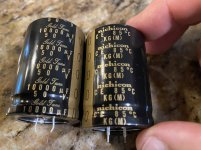 B1176C9F-8F16-47C0-9A5E-B93867031302.jpg982 KB · Views: 486
B1176C9F-8F16-47C0-9A5E-B93867031302.jpg982 KB · Views: 486 -
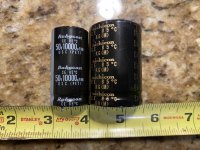 008D47FF-BC27-49D1-93A1-B076F1157BEA.jpg961.8 KB · Views: 480
008D47FF-BC27-49D1-93A1-B076F1157BEA.jpg961.8 KB · Views: 480 -
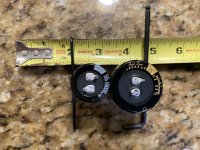 5E9EF30A-8078-43FE-A1C2-D1D5A6AAC9E4.jpg982 KB · Views: 446
5E9EF30A-8078-43FE-A1C2-D1D5A6AAC9E4.jpg982 KB · Views: 446 -
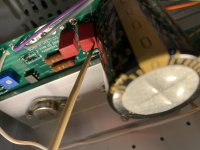 992F6B1C-1BD1-4710-B211-4E4E9A98DCEB.jpg849.7 KB · Views: 491
992F6B1C-1BD1-4710-B211-4E4E9A98DCEB.jpg849.7 KB · Views: 491 -
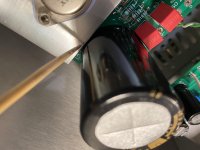 E1D16073-6E0D-441F-9994-8772452B60A3.jpg878 KB · Views: 436
E1D16073-6E0D-441F-9994-8772452B60A3.jpg878 KB · Views: 436
Pass DIY Addict
Joined 2000
Paid Member
It is my understanding that not powering up an amp without a load is mostly a tube amp thing.
It is my understanding that not powering up an amp without a load is mostly a tube amp thing.
completely different issue
Ok Thank you. I have a very tiny speaker thump. Basically nonexistent.
I do not mind some thump when cap coupled amp is powered on, at least you need to wake up those spiders
Pass DIY Addict
Joined 2000
Paid Member
completely different issue
I’m always interested in learning more 😱. Any details to share?
N. 22 is singing! And how nice it does!
First of all MANY MANY THANKS to Papa and to the entire DIYA TEAM for such a nice gift and marvelous kit.
I tried to build the amp by the book, but me being me, I did a few (very minor) mods. All but one for future experiments, one in hope to affect the sound. I know I said I wouldn't so that I could post and report on the gains or not for each mod, but regarding this simple PPP bypass cap I was simply to eager to listen to the unit than to fiddle around... Sorry, will report on the others, promised!
The very minor mods I did so far are:
- Blue connectors for signal wires to enable quick FE swaps... and at a later stage direct drive without any FE amp board
- Green connectors for PS wires to enable quick FE swaps and a quick fit of an additional SMPS Filter, should the latter materialize
- Metal stand-offs to enable quick removal or relocalization of the Filter and FE boards
- Metal lugs to enable quick addition and removal of PS caps and easy Ground connection for the 20V initial tune
- Lifted resistor on OS board to enable easy conection for the 20V initial tune
- Additional 1uF PPP cap, Panasonic ECW series for 50cents, as bypass to C2 (1000uF) for each FE boards - sorry, didn't try without, can't harm for sure and fits neatly under the board (see pix) as these are small PPP caps hence their choice (while still sounding quite fine)
- Longer connection cables, not great at this stage, but amp is nevertheless dead quiet and I simply need some headroom for my experiments, might change once I am done
For now I want to have a clear picture on how the VFET sounds without mods. I found that the sound out of the box was already very promising, but that this amp definitely benefited from some proper burn-in. The sound MASSIVELY improved already after 4h, so I found wiser to let it run for over 100h before trying to assess any (minor anyway) mod.
Last but not least, I was afraid the amp might struggle to drive my friend's Klipsch RP-8000F, (thanks for all your patience Gilles), exactly the ones I plan to purchase myself for this amp. I thought the amp might struggle re damping factor or in the bass department, or might lack fine trebles with all these caps and trannys in the way... NONE OF THIS, the VFET transcends this fine little speakers and they really go extremly well together. Great!
As expected, I need at peaks to drive these LS for reasonable listening sessions only 0.6W per channel, so the little VFET amp as enough power and margin to drive these Klipsch, while also not running into too highish distorsion levels (less syrup, I like it but not too much). I could possibly on most music materials except classic have a daily listening without the FE board (-15dB worked fine), provided I have a source with say 2.5V output (and 5V output would probably be enough for nearly any case). Hence me being on a small mod with 2x 4PDT switches enabling me direct drive for most cases (should pure VFET sound best), and FE drive for partys.
As for now, out of the box and without proper run-in, the sound improving from hour to hour, I do find (all IMHO) that the VFET is already world class regarding:
- musicality,
- fun factor (try to stop listening to it...),
- microdynamic,
- silence (dead quiet, better than a Class D amp!),
- tonality (marvelously natural at these low power levels, "rich" but realistic),
- airyness, 3D soundstage and soundstage size,
- single voices,
- most details,
- easygoing,
- fusion of all registers
It is currently still improving on:
- macrodynamic
- some minor graininess
- soundstage precision / instrument placing / left-right ping pong effect
- speed and slam on single instrument variations
- control over complex music
- control over the bass
Don't get me wrong, it is already a wonderfull little amp, world class in most departments, and still improving in the latters I mentioned. I can't say yet if it will (to my taste and in this system!) reach top class in these, but if not I still have some ideas to try re signal caps bypass, FE swaps or bypass, SMPS filtering, additional PS caps (channel separation and dynamic could benefit from these perhaps as reported by others).
Fascinating, and the best thing is my wife loves the look of this little amp, which is excellent because she will be the main user in our living room!
All IMHO of course
Enjoy music
Claude
PS: yes, it runs quite hot, probably close to 50°C at the fins, and even the front plate helps dissipating quite a lot of heat, but no concern for kids to get burned so no problem at all unless your listening room gets hotter than 35°C
First of all MANY MANY THANKS to Papa and to the entire DIYA TEAM for such a nice gift and marvelous kit.
I tried to build the amp by the book, but me being me, I did a few (very minor) mods. All but one for future experiments, one in hope to affect the sound. I know I said I wouldn't so that I could post and report on the gains or not for each mod, but regarding this simple PPP bypass cap I was simply to eager to listen to the unit than to fiddle around... Sorry, will report on the others, promised!
The very minor mods I did so far are:
- Blue connectors for signal wires to enable quick FE swaps... and at a later stage direct drive without any FE amp board
- Green connectors for PS wires to enable quick FE swaps and a quick fit of an additional SMPS Filter, should the latter materialize
- Metal stand-offs to enable quick removal or relocalization of the Filter and FE boards
- Metal lugs to enable quick addition and removal of PS caps and easy Ground connection for the 20V initial tune
- Lifted resistor on OS board to enable easy conection for the 20V initial tune
- Additional 1uF PPP cap, Panasonic ECW series for 50cents, as bypass to C2 (1000uF) for each FE boards - sorry, didn't try without, can't harm for sure and fits neatly under the board (see pix) as these are small PPP caps hence their choice (while still sounding quite fine)
- Longer connection cables, not great at this stage, but amp is nevertheless dead quiet and I simply need some headroom for my experiments, might change once I am done
For now I want to have a clear picture on how the VFET sounds without mods. I found that the sound out of the box was already very promising, but that this amp definitely benefited from some proper burn-in. The sound MASSIVELY improved already after 4h, so I found wiser to let it run for over 100h before trying to assess any (minor anyway) mod.
Last but not least, I was afraid the amp might struggle to drive my friend's Klipsch RP-8000F, (thanks for all your patience Gilles), exactly the ones I plan to purchase myself for this amp. I thought the amp might struggle re damping factor or in the bass department, or might lack fine trebles with all these caps and trannys in the way... NONE OF THIS, the VFET transcends this fine little speakers and they really go extremly well together. Great!
As expected, I need at peaks to drive these LS for reasonable listening sessions only 0.6W per channel, so the little VFET amp as enough power and margin to drive these Klipsch, while also not running into too highish distorsion levels (less syrup, I like it but not too much). I could possibly on most music materials except classic have a daily listening without the FE board (-15dB worked fine), provided I have a source with say 2.5V output (and 5V output would probably be enough for nearly any case). Hence me being on a small mod with 2x 4PDT switches enabling me direct drive for most cases (should pure VFET sound best), and FE drive for partys.
As for now, out of the box and without proper run-in, the sound improving from hour to hour, I do find (all IMHO) that the VFET is already world class regarding:
- musicality,
- fun factor (try to stop listening to it...),
- microdynamic,
- silence (dead quiet, better than a Class D amp!),
- tonality (marvelously natural at these low power levels, "rich" but realistic),
- airyness, 3D soundstage and soundstage size,
- single voices,
- most details,
- easygoing,
- fusion of all registers
It is currently still improving on:
- macrodynamic
- some minor graininess
- soundstage precision / instrument placing / left-right ping pong effect
- speed and slam on single instrument variations
- control over complex music
- control over the bass
Don't get me wrong, it is already a wonderfull little amp, world class in most departments, and still improving in the latters I mentioned. I can't say yet if it will (to my taste and in this system!) reach top class in these, but if not I still have some ideas to try re signal caps bypass, FE swaps or bypass, SMPS filtering, additional PS caps (channel separation and dynamic could benefit from these perhaps as reported by others).
Fascinating, and the best thing is my wife loves the look of this little amp, which is excellent because she will be the main user in our living room!
All IMHO of course
Enjoy music
Claude
PS: yes, it runs quite hot, probably close to 50°C at the fins, and even the front plate helps dissipating quite a lot of heat, but no concern for kids to get burned so no problem at all unless your listening room gets hotter than 35°C
Attachments
Great to hear about your progress, and listening impressions.
My experience was similar during the initial 100 hours of run in. I did add the separate caps to the internal power rail relatively early, and the amp continued to improve in the same areas you mentioned afterward.
The most recent addition was a pair of Nichicon KW series 470 uF caps in parallel with the big output caps. Those had a brief run-in period of their own, and had a nice effect to the sound of the amp.
My experience was similar during the initial 100 hours of run in. I did add the separate caps to the internal power rail relatively early, and the amp continued to improve in the same areas you mentioned afterward.
The most recent addition was a pair of Nichicon KW series 470 uF caps in parallel with the big output caps. Those had a brief run-in period of their own, and had a nice effect to the sound of the amp.
Last edited:
I’m always interested in learning more 😱. Any details to share?
there is quite a number of threads already about it
What happens when an output transformer has an open secondary?
What kills an opt tranny?
Indeed, Tungstenaudio, your posts were inspirational regarding the PS bypass caps... I have two Panasonic FC 1500uF/50V low ESR caps ready to go, and all is prepared sides the OS boards and sides the cap legs. Top pannel off, some blutack to hold the caps while doing 2x2 soldering points, job done. Quick comparisons will be possible thanks to the "G" and "+V" extensions I have put on the OS boards.
Regarding the bypass caps at the OS output, I ordered some Nichicon KZ 220uF/50V ones. In fact somewhere between what you did and what I had planned initialy some time ago. Will be soldered underneath, it is just a try I wanted to perform anyway, albeit with say 100uF initialy... but your link to the FW amp finished to convince me to move slightly upwards from the middle position with the 0.33uF cap, just in case. Thanks again for sharing all this...
Listening directly to the OS board to evaluate the impact of the FE board should be also an interesting experiment, be it just for my personal curiosity re direct VFET sound 🙂
If I somehow fit the switches I just received, I shall also be able to compare quickly any FE board vs a kind of benchmark consisting of the pure VFET. I like it to have a fixed consistant baseline when comparing FEs, as I can't switch instantely.
More fun ahead, well noting that it will be difficult to unplug the little sonic wonder, as it really sounds so good, meaning configuration changes for experiments are best done very quickly 🙂
Enjoy music
Claude
Regarding the bypass caps at the OS output, I ordered some Nichicon KZ 220uF/50V ones. In fact somewhere between what you did and what I had planned initialy some time ago. Will be soldered underneath, it is just a try I wanted to perform anyway, albeit with say 100uF initialy... but your link to the FW amp finished to convince me to move slightly upwards from the middle position with the 0.33uF cap, just in case. Thanks again for sharing all this...
Listening directly to the OS board to evaluate the impact of the FE board should be also an interesting experiment, be it just for my personal curiosity re direct VFET sound 🙂
If I somehow fit the switches I just received, I shall also be able to compare quickly any FE board vs a kind of benchmark consisting of the pure VFET. I like it to have a fixed consistant baseline when comparing FEs, as I can't switch instantely.
More fun ahead, well noting that it will be difficult to unplug the little sonic wonder, as it really sounds so good, meaning configuration changes for experiments are best done very quickly 🙂
Enjoy music
Claude
I also experimented with adding caps to the same place on the OS boards. I tested with dry fitting the 470uf 80v Nichicon caps I had on hand. No discernible change in sound, but the turn on thump was eliminated. That’s what I was going for, so I soldered them in place under the board.
Claude, nice read! Congrats on the amp build!…left-right ping pong effect
I must confess I had never heard this term of “ping pong” effect, nor had I experience it.
But mine definitely does that: a rogue small bump in loudness (or perhaps a small echo-like effect) in one channel that momentarily “displaces” the stereo imaging. It’s very noticeable on single voices or instruments.
Kind of like if there was too much pressure in the pressure cooker and then it just “releases” that extra pressure and returns to normal.
What could cause this? I would say my Amp is well passed the 100 hour mark.
I also will probably need to re-measure the pot biassing as i sense a slight imbalance and the right speaker is louder, so stereo placement shifts to the right. For the time being I dialed -3dB through ROON, which is almost a crime! 🙂
Thanks for sharing!
Rafa.
I have been playing my VFET with a set of new JBL Studio 530’s. These are really decent speakers on sale for $250 shipped direct from JBL. The price was too low and I could not resist. 🙂 Bi radial horn loaded compression driver tweeter and 5.25in ported woofer. They probably are voiced a tad bright so I added a 2ohm resistor between the amp and tweeters and that made the tonal balance much nicer. This is easy to do since tweeter and woofer have separate binding posts. The VFET can drive these to surprisingly loud levels and they still sound clear. The two are a great match.
I have 9 amps in this shelf (LuFo, LSA GaN, FH9HVX, LM-211ia, Alpha Nirvana, IcePower 1200AS2, VFET, TDA7293 Xmas Amp, and VHEX+. Most driven by hybrid tube SS SE/Bal buffer with gain. Most of the amps mounted with their rear ends facing out makes swapping amps a snap. I also have an A/B switch to compare two amps with one set of speakers. The VFET is currently in rotation for past 3 days.

I have 9 amps in this shelf (LuFo, LSA GaN, FH9HVX, LM-211ia, Alpha Nirvana, IcePower 1200AS2, VFET, TDA7293 Xmas Amp, and VHEX+. Most driven by hybrid tube SS SE/Bal buffer with gain. Most of the amps mounted with their rear ends facing out makes swapping amps a snap. I also have an A/B switch to compare two amps with one set of speakers. The VFET is currently in rotation for past 3 days.
Attachments
Last edited:
Hi TungstenAudio,
Yep, those Nichicon KZ were chosen for their quality based on the specsheet and I wanted to give them a try. They were my second choice, first one wasn't avail before ages at Mouser and even these are in back order and should hopefully reach me before my summer brake.
Yep, those Nichicon KZ were chosen for their quality based on the specsheet and I wanted to give them a try. They were my second choice, first one wasn't avail before ages at Mouser and even these are in back order and should hopefully reach me before my summer brake.
Hi VonAh,
I am lucky as I have absolutely no turn on hump so far.
My amp looks like a mess with all his connectors and longish cables and tall stand offs, but the beauty is I can change configuations within a few miniutes to allow quick comparison. I will solder the 1500uF caps and report on sound changes if any. As everything is ready for that, caps in and out is just taking the top pannel off and 2x2 soldering points with caps having already the appropriate legs 🙂
i had even thought to put connectors there to avoid soldering but this quick soldering should be so easy I saw no point not doing it right LOL
I am lucky as I have absolutely no turn on hump so far.
My amp looks like a mess with all his connectors and longish cables and tall stand offs, but the beauty is I can change configuations within a few miniutes to allow quick comparison. I will solder the 1500uF caps and report on sound changes if any. As everything is ready for that, caps in and out is just taking the top pannel off and 2x2 soldering points with caps having already the appropriate legs 🙂
i had even thought to put connectors there to avoid soldering but this quick soldering should be so easy I saw no point not doing it right LOL
Hi Rafa,
Well, perhaps I wasn't completely clear as I meant something different with ping pong effect, sorry!
First off I am rather holding off regarding real sonic comments before the amp is ran in. I gave initial directions only, the amp is evolving very quickly in the right direction. Because it changes so much, I want to wait for 300h before doing any mod, so I can assees if the changes were due to my mods and avoid me thinking a mod was benefical where simple running-in was at play.
By ping-pong I meant that whereas the stage was huge in every dimension and quite stable, sometimes, like in first stereo recordings, it sounded somewhat stretched and caricatural with instruments being directly located at one or the other LS, but never moving from another or jumping like you described. To be precise, the VFET amp has already transformed these horns close to something I like very much: panels! I love it. 90% is already there, but this effect. I shall wait, perhaps running-in ot the mods will change that. I also thought that the toe-in of the LS could be at fault and that they would require another placing due to the extented soundstage, and that is also very likely. The Klipsch are quite special in that aera, they sound best with excessive toe-in (ve my magnetostats that sound great with little or no toe-in).
We whall know more in a week's time, meanwhile I am sorry for the little help as what you describe is quite a different issue.
Claude
Well, perhaps I wasn't completely clear as I meant something different with ping pong effect, sorry!
First off I am rather holding off regarding real sonic comments before the amp is ran in. I gave initial directions only, the amp is evolving very quickly in the right direction. Because it changes so much, I want to wait for 300h before doing any mod, so I can assees if the changes were due to my mods and avoid me thinking a mod was benefical where simple running-in was at play.
By ping-pong I meant that whereas the stage was huge in every dimension and quite stable, sometimes, like in first stereo recordings, it sounded somewhat stretched and caricatural with instruments being directly located at one or the other LS, but never moving from another or jumping like you described. To be precise, the VFET amp has already transformed these horns close to something I like very much: panels! I love it. 90% is already there, but this effect. I shall wait, perhaps running-in ot the mods will change that. I also thought that the toe-in of the LS could be at fault and that they would require another placing due to the extented soundstage, and that is also very likely. The Klipsch are quite special in that aera, they sound best with excessive toe-in (ve my magnetostats that sound great with little or no toe-in).
We whall know more in a week's time, meanwhile I am sorry for the little help as what you describe is quite a different issue.
Claude
- Home
- Amplifiers
- Pass Labs
- DIY Sony VFET Builders thread
